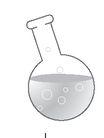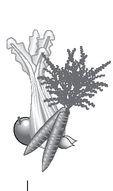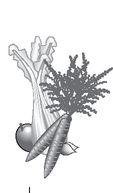Chapter 1
Growing Your Own Food
In This Chapter
• The growth of agriculture
• Learn why fresh produce is so satisfying
• Specialty and hard-to-find items you might want to grow
• What does organic gardening really mean?
• Easy ways to save money when you grow your own produce
Nothing is more basic than food. The earliest humans learned this the hard way, chasing after bison and bears with nothing but a big rock to kill them. It didn’t take long—only a few thousand years—for our ancient ancestors to figure out that life is easier with a steady source of food, and the only way to have a truly reliable supply is to grow it. Thus agriculture was born. With agriculture came farming and gardening, and the rest is history.
In this chapter, we look at how our long-ago relatives tamed plants and carried them from continent to continent, developing new ways to garden along the way. And we see why growing produce has become one of America’s favorite pastimes.
A Little History
About 12,000 years ago, human beings had had enough of their primitive hunting and gathering existence. They had, by that time, discovered fire and come to the realization that cooked food was a lot tastier than raw food. These early men and women had also learned how to craft crude cooking vessels out of bark, seashells, tortoise shells, and eventually clay and metal. Some of the smarter members of the human clan had cleverly devised food combinations that met their bodies’ nutritional needs and had begun to mix meat and fish with collected fruits, roots, leaves, and seeds in their new cookware, making tasty soups and stews.
Because the hunting and gathering lifestyle was difficult and unpredictable, the very smartest folks developed ways to make plants grow in convenient places. (They also domesticated animals, but that’s another book.) So around 10000 B.C.E. in what is now the Middle East, agriculture was born and soon spread to the Western Mediterranean and points north and east.
Prof. Price’s Pointers
To sustain life, humans must consume foods that contain sugars (carbohydrates), proteins (nitrogen components), lipids (fats), micronutrients (minerals and vitamins), and fibers. All these essential nutritional elements are available by consuming a variety of plant species.
Over the next 10,000 years, farmers began to cultivate new food plants all over the world. In 7000 B.C.E., walnuts and beans were first planted. 6000 B.C.E. was a big year for corn. Grapes, oranges, and watermelons got their cultivation start around 4000 B.C.E. By 3000 B.C.E., barley, peas, carrots, onions, fava beans, and apples became part of the farmer’s repertoire.
The vegetables and fruits we grow and eat today are either Old World or New World plants. From a historical perspective, Christopher Columbus gets the credit for introducing most of the New World plants to Europe.
New World foods include the following:
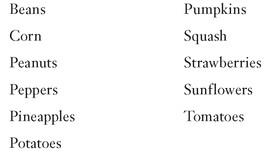
Old World foods include these:
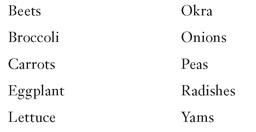
It’s hard to believe that at one time, lettuce, peas, and radishes were rare and exotic. Today, we take even some of the most esoteric foods we eat for granted. When I (Daria) was growing up in the 1950s and 1960s, lemongrass might have been available in San Francisco, but the produce manager at the A & P in Arlington, Massachusetts, probably never heard of it. In the late 1970s, when I taught a class in Mexican cooking at the YMCA, I had to order cilantro by mail from a specialty house in New York. Now it’s carried in most grocery stores.
With modern commerce, we are able to enjoy foods from every corner of the globe. And with the huge number of seed and plant growers and vendors, just about everything is available to grow yourself.
Fresh Is Best
If you’ve never picked a tomato from the vine and taken a bite right there in the garden, you don’t really know what fresh food is. Harvesting edible plants and consuming them immediately is one of life’s most sensual pleasures.
When I was a very young child, my family had a favorite summertime ritual—while Mom started a big pot of water on the stove, Dad and the kids would drive a short distance to a neighborhood farm where the farmer would let us pick our own corn. We would shuck the ears while Dad drove, and by the time we got home, the water would be boiling on the stove. In went the corn and, a few minutes later, we sat down to feast. That’s as fresh as it gets.
With recent nutrition research proving that canned, frozen, and otherwise processed fruits and vegetables might be just as good, or even better, for us than their fresh counterparts, should we be less interested in growing our own? Absolutely not!
While most of us might assume that our homegrown foods might be more healthful, one of the reasons we are willing to do all the work that goes into producing produce is because fresh fruits and vegetables taste so much better.
Concern for carbon emissions from transporting food around the world, and pollution from overuse of nitrogen-based fertilizers from some growing practices are also big factors in people’s motivation to grow their own food. Many environmentally conscious folks are turning to locally grown, organic foods to reduce pollution and help reduce their carbon footprint. Some strict locavores, like Colin Bevin, a.k.a. No Impact Man, strive to consume products raised within a 100-mile radius of their homes.
Prof. Price’s Pointers
Fresh fruits and vegetables are undeniably wholesome and healthful, but eating them raw isn’t necessarily the healthiest approach. According to a study published in 2000 by the American Chemical Society, the antioxidant levels of carrots increased dramatically immediately after being cooked to the point of mushiness. Research done in 2002 at Cornell University showed that the antioxidant value of tomatoes increases significantly when the tomatoes are cooked. In fact, many canned or frozen vegetables (but not broccoli, according to a 2008 scientific paper) and fruits have more nutritional or disease-prevention value than their raw counterparts.
It’s a Matter of Taste
People garden for many reasons, but one of the primary motivating factors is taste. Homegrown vegetables and fruits taste far superior to anything you can buy in a store. Sure, roadside stands and farmers’ markets sell great stuff, but nothing is as fresh as right out of your own garden.
Gardening gives you the opportunity to experience foods in a different way from what you’re used to. You know where the fruits and vegetables come from, what went into growing them, how they’ve been handled, and how fresh they are. You can plan meals based on what’s ripe right now. And you can choose to grow those things you savor most without being at the mercy of a produce manager’s whim.
Food for Thought
The natural sugars in fruits and vegetables give them the flavors we like so much. After harvest, when the fruit is removed from the plant, those sugars quickly convert to starch that has a different and less stimulating taste. The longer the fruit sits before you eat it, the less sugar is available to produce the flavor.
Of course, there are limitations. The grocery store can offer asparagus and artichokes most of the spring and summer as they come in from various places around the world. The home gardener has one season—and that’s often all too brief. But the joys of some other vegetable whose time to shine has come might be enough consolation.
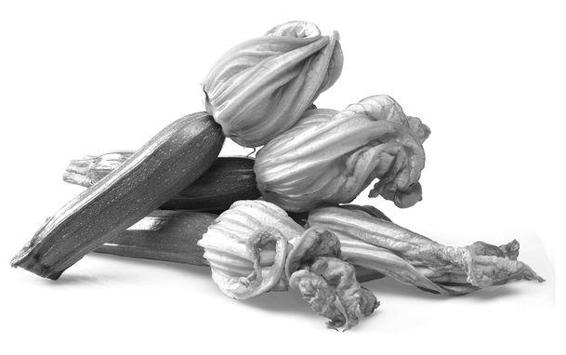
Squash blossoms aren’t typical grocery store fare, but if you grow your own zucchini, you can harvest these beautiful blooms to serve sautéed, lightly breaded and fried, or stuffed.
Specialties of the House
One of the best rewards of gardening is the opportunity it gives you to grow something special, something different from the ho-hum veggies found in every grocery store. For just a few dollars, you can become a specialist in Asian or Mexican vegetables. With a handful of herb plants and a little research, suddenly you are an expert on subtle seasonings or herbal remedies.
Growing your own food plants is so versatile, too. With successive plantings, you can add new things midseason or stop planting something that didn’t work out well. You can change your approach from year to year.
Here are some specializations you might want to consider:
• A wide variety of one type of plant (beans, squash, cabbages, etc.)
• Baby and dwarf vegetables
• Produce for pickling
• Salad fixings (including 10 types of lettuce)
• Asian stir-fry foods
• Onions and their relatives
• Peppers (from hot to sweet)
Garden Guru Says
Most vegetables we eat are actually fruits—
the ripened ovaries of a plant’s flowers. Tomatoes, zucchini, and corn are all fruits of the plants on which they grow. Melons and strawberries are also fruits.
• Heirloom vegetables
• Pumpkins or melons
• Fancy potatoes
• Tomatoes
• Latino cooking ingredients
• Herbs for French cuisine
• Medicinal herbs
One of the great things about gardening is the flexibility it gives you to try growing new things or the same old thing but with a new method.
A Look at Organic Gardening
There are organic gardeners, and there are Organic Gardeners. Those truly committed to creating and maintaining a completely organic garden should understand that it requires more than simply forgoing pesticides and herbicides. Having an organic garden means you embrace an entire set of standards. In fact, there’s a process for becoming certified as organic.
The USDA points out that the “principle guidelines for organic production are to use materials and practices that enhance the ecological balance of natural systems, and that integrate the parts of the farming system into an ecological whole.”
Here are some basic organic gardening rules:
• Select a location that’s appropriate for the plants you will grow.
• Prepare the soil with organic material.
• Choose disease-resistant varieties of plants.
• Rotate crops to avoid infestations and soil depletion.
• Compost your plant material and debris.
• Use compost and other organic material to enhance soil.
• Use nonchemical approaches to disease and insect control.
• Conserve water.
• Avoid use of power equipment.
We look more extensively at organic practices later in this book.
Protecting the Environment
Whether or not you’re planning to garden organically, it’s a good idea to understand why so many people are interested in this concept.
A major source of water pollution in the United States is fertilizer residues in storm water runoff. A great deal of that fertilizer comes from farms, but also from lawn and garden applications by homeowners. In addition, research indicates that most homeowners use far more than the recommended amounts of herbicides and pesticides when they treat their gardens and lawns. Careless watering is another problem in many parts of the country where several years of drought have strained supplies.
Careful use of resources and products is an intelligent way to approach gardening, whether or not you’re willing to comply completely with organic principles.
Take, for example, David Benner, a gardening friend who lectures and writes about his gardening practices. He has one of the most Earth-friendly gardens you can imagine. While he specializes in shade plants, moss, and native flowering shrubs, his techniques would translate well to vegetable gardens.
Food for Thought
Consider this equation: you buy 10 young tomato plants for $2 a piece and each plant yields about 20 pounds of tomatoes. Calculated at $1.99 per pound, the price you might pay at a local farm stand, your $20 investment gives you about $400 in fresh, delicious tomatoes—enough to eat fresh all summer long with a few left over for canning or drying.
David removed every last square inch of grass from his property so he would no longer have to use a noise- and air-polluting lawn mower. He composts all his garbage and garden debris and uses the rich results to amend the soil and feed the plants. He faithfully conserves water and encourages native plants that require less water than exotic imports. David grows only those plants that are appropriate to the climate and conditions in his garden.
Protecting the Hyper-Allergic
Allergies are a problem for millions of people. For some, an allergy might be little more than an annoyance, but for others, an allergy to a food or environmental factor can be life threatening.
For those who have serious environmental allergies, especially allergies to insecticides, pesticides, and herbicides, growing foods organically or with an organic approach might be one of the few ways to have some control over quality of life.
Money in Your Pocket
Fussy consumers spend lots of money on organic or unusual vegetables at specialty stores, roadside stands, and farmers’ markets. And they pay hefty prices for the very best stuff. Artichokes go for $2 or $3 apiece. A tiny sprig of rosemary is $2.99. And the mesclun? Try $12 a pound—if you can find it. Even plain old no-frill vegetables can be as costly as chicken or beef.
There is a better way. Growing your own produce can save you money. A friend of mine raises fancy mixed lettuces in a flat on her terrace. Her $9 investment in seeds, the seed tray, and potting mix rewards her with gourmet salad for two for most of the summer.
In addition to growing your favorite vegetables and fruits, why not grow the most expensive ones? Most won’t cost any more to grow than the low-cost varieties.
Here are some of the more expensive types you might want to try:

String beans are relatively inexpensive, but dainty French filet beans cost a fortune. The zucchini is practically given away by midsummer, so grow tiny, trendy, patty pan squash instead. And even if you can afford to pay for squash blossoms, try finding them even at the fanciest of green grocers.
When you grow your own produce from seed, the savings become even greater. Take, for example, fancy mesclun salad mix. These beautiful little salad greens can be prohibitively expensive, especially for everyday salads. But Johnny’s Selected Seeds (www.johnnyseeds.com), for example, sells a gourmet mesclun mix for $4.30, with 1,200 seeds that will produce so much of the delicate, delicious stuff, you’ll be giving it away to grateful friends.
Some wonderful fruits and vegetables have a relatively high initial investment, but they have a big payoff down the road. Asparagus, artichokes, and strawberries all should be started from plants rather than seed. It could cost $100 or more to start an asparagus patch, but 5 years later when you’re still picking those exquisite shoots, you’ll know it was worth every penny. Plus, if you take the time to can, freeze, or dehydrate the bounty, gardening can save you lots of money.
The Least You Need to Know
• Growing your own vegetables and fruits yields a steady supply of your favorites.
• You can create a specialty garden to supply your passion for particular types of cooking or flavoring.
• Fresh vegetables taste best, but their nutritional and disease-prevention qualities might not be quite as high as their canned or frozen counterparts.
• It’s important to really understand what organic gardening means before you give yourself that label. But if strictly organic is too far a reach, keep in mind that even your smallest Earth-friendly efforts are worthwhile.
• Growing your own vegetables and fruits can greatly extend your food budget.
